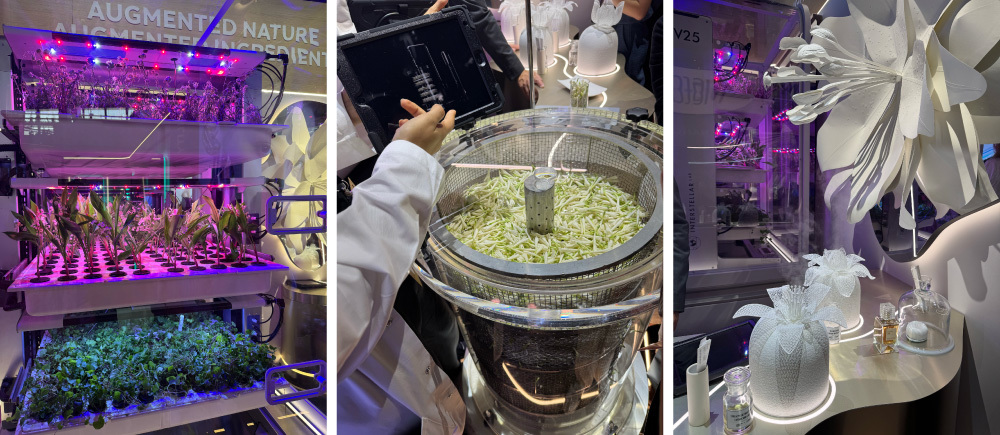Hello, I'm Kana Nakano from Dentsu Lab Tokyo. As part of the lab's R&D activities, I visited "Viva Technology 2025," Europe's largest tech event, held in Paris, France, from June 11 to 14, 2025. In this second part, I'll share examples of collaborations between major corporations and startups, as well as the atmosphere at the country-specific booths.
LVMH Utilizes AI from Grapes to Stores

The LVMH booth, positioned centrally at the venue, showcased 15 startups collaborating with its maison brands. The lace-like interior was designed by Aectual, winner of last year's LVMH Prize for Innovation, utilizing recycled materials and 3D printing technology.
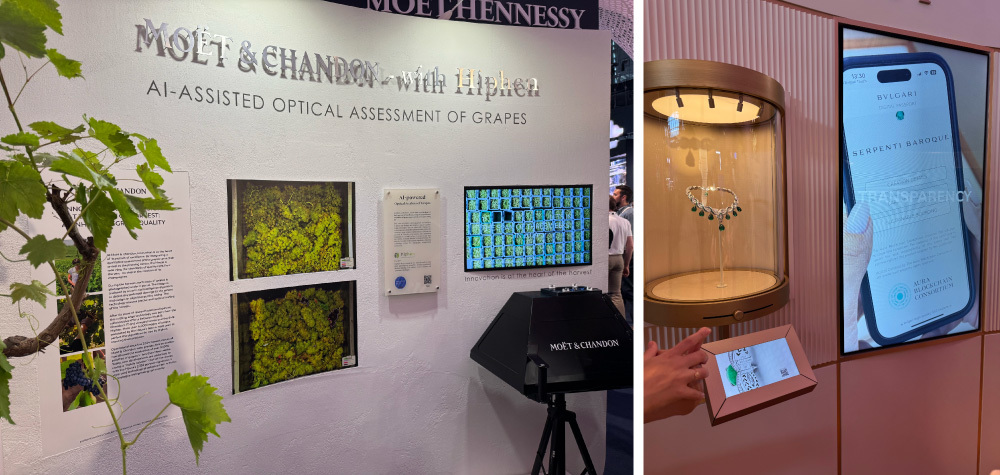
Moët & Chandon utilizes AI in a system that identifies diseases and damage in grapes. Through a collaboration with Hiphen, which provides agricultural image analysis solutions, an algorithm trained on over 6,000 annotated grape images can now complete quality assessments for over 16,000 pallets of grapes in just three weeks. This system was rolled out to all Moët & Chandon presses in 2024. A mobile inspection kit, resembling the black device in the center of the photo, has also been developed for partner growers.
Bulgari achieves jewelry traceability with AI. Through collaboration with Dev4Side, a dedicated app reads micro-engraved serial numbers invisible to the human eye, enabling verification of authenticity, origin, and access to support.
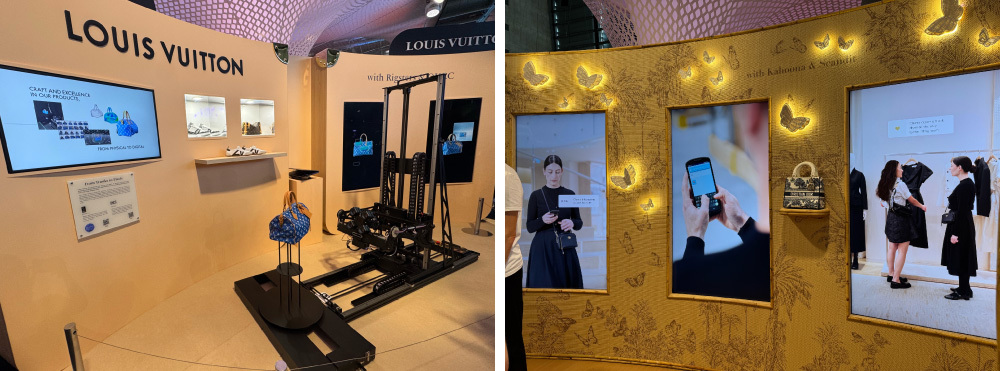
Louis Vuitton demonstrated AI-generated product imagery. Using Rigsters' robotic cameras to capture 360° product shots and convert them to 3D models, combined with OKCC's generative AI solution to create brand-aligned backgrounds, this approach facilitates website and campaign localization.
Dior leveraged AI for personalized online experiences. Its partner Kahoona's solution, which digitally profiles site visitors to predict customer profiles and behaviors like an experienced in-store associate, enabling real-time responses to individual needs, earned the company the Best Business Award at the LVMH Innovation Awards.
L'Oréal's booth featured striking visuals created with generative AI
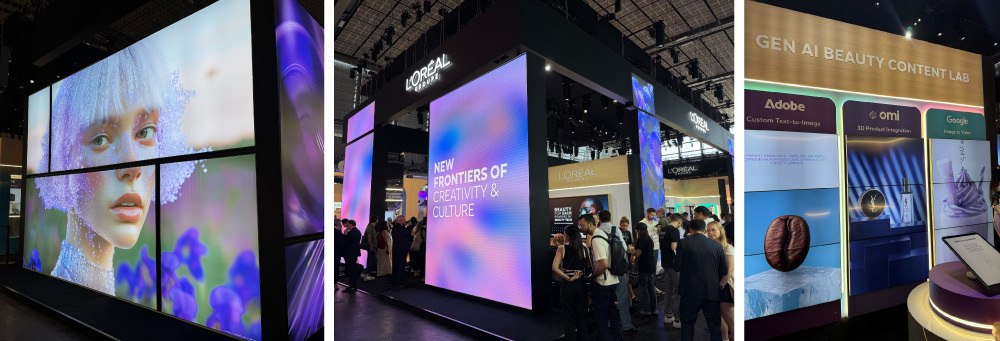
L'Oréal's booth drew attention with futuristic visuals. CREAITECH, an internal generative AI lab announced at last year's VivaTech, was created to accelerate product development and advertising production tailored to each brand. The booth featured an interactive corner where visitors could experience generating brand-specific images and videos.
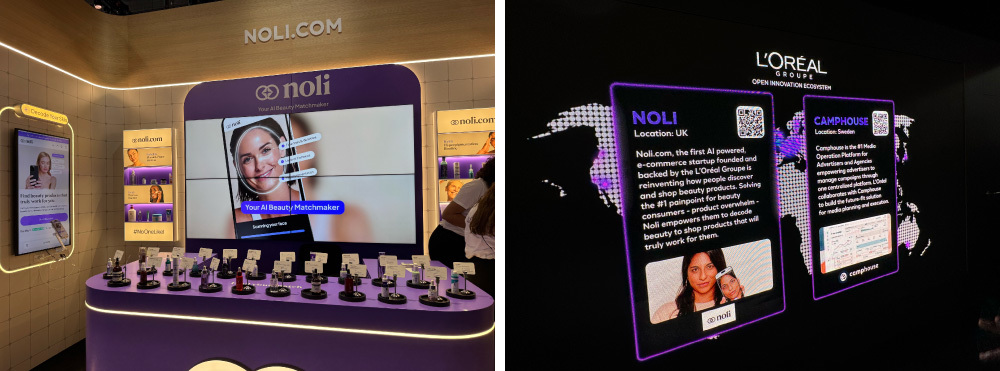
Noli (No one like I), a multi-brand beauty marketplace powered by AI and founded by L'Oréal, announced collaborations with NVIDIA, Accenture, and Microsoft. It features an AI diagnostic tool that matches products based on the user's "beauty profile." The AI analyzes over one million skin scan data points and thousands of product formulation data points to deliver the optimal products from multiple brands to each user's home, tailored to their individual skin type and concerns.
There was also a sustainable AI application aiming to create high-quality products while reducing environmental impact. A vertical farming system for cultivating plants used as perfume ingredients was developed by France's Interstellar Lab. The company develops food production technologies for space stations and Mars. It reportedly maintains traditional quality while optimizing water and nutrients to reduce resource consumption and cut energy used for transportation.
Additionally, new technology for extracting fragrance components from cultivated plants was introduced. This method collects volatilized fragrance components using airflow instead of heating or cooling, enabling the extraction of fragrance components previously unattainable with conventional techniques.
Canada: AI Distinguishes Whales from Cancer
This year's Canadian national booth featured the humanoid robot Ameca at its center. While manufactured by UK-based Engineered Arts, its responses utilized programming from Canada's IVADO LABS. Designed to answer questions about AI and the booth itself, it drew crowds. Reveal AI, a finalist for the newly established "Tech for Change" award at Viva Tech this year, exhibited a tool enabling real-time molecular diagnostics within living organisms by combining optical methods with AI. It reportedly helps reduce recurrence rates by accurately determining the area to be excised during cancer surgery.
Other startups showcased AI-powered businesses, including software proposing the most efficient loading patterns for containers and warehouses via 3D visuals, tools for automatically detecting marine mammals like whales to prevent ship collisions and aid ecological research, and a veterinary app estimating a cat's pain level from its facial expressions.
AI-related companies also won at the Africatech Awards

Due to France's geographical and linguistic affinity, African exhibitors have actively participated in VivaTech every year. This year, eight countries, including Senegal, Côte d'Ivoire, and first-time exhibitor Guinea, had booths. At the 4th Africa Tech Awards, Nigeria's Zeeh Africa won in the e-commerce & fintech category. With many people lacking bank accounts, their system of using AI to assess creditworthiness based on smartphone transaction history and behavioral pattern data was highly regarded. In the green tech category, South Africa's Plentify, which developed an AI-powered home energy management platform, took home the award.
Who decides "for whom, with whose data, and by whom it should be designed"?
At VivaTech 2025, "AI" was the star of the show. The letters were seen everywhere in the venue, and AI was introduced as being used in various fields, from luxury brands to healthcare, the environment, and finance. It was an event where you could really feel how deeply AI has penetrated our lives, with major companies and startups joining forces to tackle social issues and create new businesses.
However, developing AI requires vast amounts of data and computational resources, inevitably leading to a concentration of this technology among a few large corporations and nations. This means decisions about what data to use and what values to design by are entrusted to a limited number of players. This could lead to information bias and skewed decision-making that impacts our lives.
In response to these concerns, efforts are advancing, such as developing AI for minority languages and the movement toward "data sovereignty," where countries manage their own data domestically. While locally rooted technology development is a welcome trend, it simultaneously carries the risk of fragmenting AI rules and values across nations and regions. Striking the right balance between global coordination and local autonomy is a major challenge ahead.
What struck me most during this event is how crucial the questions "For whom? Using whose data? Designed by whom?" have become when considering how to implement AI in society. And answering these questions may not just be up to companies or governments, but to each and every one of us.
During this inspection tour, Dentsu Lab Tokyo also shared some "behind-the-scenes stories. " Detailed reports on the inspection are available (for a fee), so please feel free to inquire.







